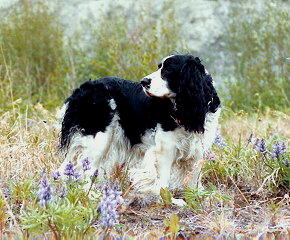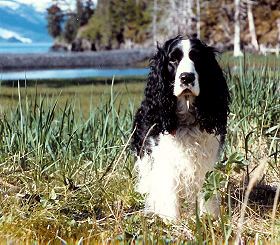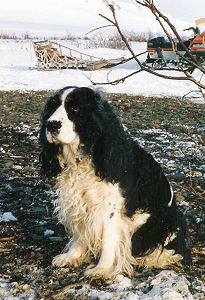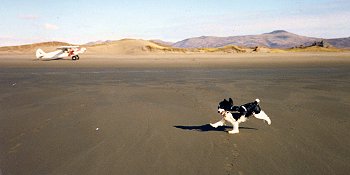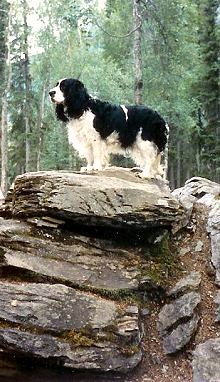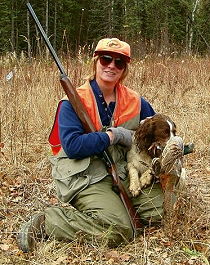 
The first springer that "owned me" was Maggie's Peggy Jean CD - call name
Peggy. She was half west Texas, hard hunting field bred and half show bred.
I found her in Jal, New Mexico. Born in a litter of six, she was the gorgeous
black and white, show bred looking pup that won me with her bright clean blaze, soft brown eyes and her white tail showing below a black saddle. She would
retain that show beauty her whole life, but would never be a show dog as her
neck was too short and her tail set too low. And she had this funny way that she
walked sideways with her hind end a full three or four inches left of her
front half. It was a comical sideways gait that I followed for twelve years as she hunted her heart out for us. Peggy may have inherited her father's show looks, but
she inherited her mom's hunting heart - and hunt she did.
Peggy's life was ever changing. She came into my life during a time when I
was still married to my ex-husband who, on a drop of a hat, would quit his job
and head off for new adventures. We moved eleven times in Peggy's twelve years.
Her first year was spent in Hobbs, New Mexico, absorbing the obedience I was
teaching her - learning faster than any dog I had ever known. She earned her
CD at eleven months of age. Competing in our first obedience trial - earning her
first leg, we were just leaving the grounds when they kept calling our name. We were presented with the "highest scoring dog in trial" award - something I didn't know even existed. From there, we were just started on her CDX.. until her first real bird hunt got in the way.
"Peggy opened my life to the world of spaniels, and now I am an AKC hunt test judge, run my dogs in hunt tests and compete in the National Bird Dog Challenge."
I didn't have access to training birds, so had trained her to retrieve with a stuffed sock and had got her used to gunfire. Our first hunt was a trip to my childhood family property - the only wheat field in western New Mexico and it was wonderfully packed with morning doves. I lived to hunt doves, an affliction soon to infect Peggy. On September first, opening morning, I managed to drop a bird after about a dozen shots. In my childhood years with my little single shot 20 that had a setter engraved on the side, I averaged a dove per box. When I turned sixteen my dad presented me with his AH Fox Sterlingworth sweet 16 gauge. My shooting average instantly went up to two doves per box and I thought I was hot stuff!
When that first bird dropped, Peggy did as trained, racing out to retrieve the downed bird. There was no hesitation on her pickup of first feathers. With a happy
expression and perpetually wagging white tail, she brought it back with head
high and proud, savoring the feel of it in her mouth. A bird dog was born.
She never missed a retrieve after that. But our CDX was doomed because from that day forward she refused to retrieve anything but fur, fish and feathers - training dummies, and dumbbells were out of the question. Yes, I could have force trained her, but I understood her spirit and new passion. She had learned what she was meant to do and I had me a hunting buddy for life.
After her first birthday, we went traveling - working contracts to take out
abandoned communication pole lines for the railroads stretching from
Washington State, across the Midwest, east towards Chicago and ending up on the
Mississippi River. The railroads were switching from the old telephone
lines to the new microwave technology, so the lines were being sold off to the
highest bidders.
I learned quickly that railroad tracks were great wildlife habitat. With clean farming techniques, the lines were the only place with cover - thus a necessity for birds and other wildlife. Peggy spent every day out with us. While we worked from pole to pole, she discovered bird hunting. In Washington state, she flushed her first pheasant which then became her primary focus. Every day for close to six months she worked wild pheasants, learning their life ways and tricks of escape. I agonized as I wanted to hunt so badly - but my non-hunting, workaholic husband wouldn't allow the time out or spend the money for a license to let Peggy and I
follow our desires. Peggy became bird crazy, watching the skies constantly
and working cover she knew would produce a flush. She never stopped hunting. My poor little dog never got to hunt pheasants then, in fact, she was close to twelve when she finally got to go on her first pheasant hunt many years later in Kansas. I traded an Alaskan moose hunt for a Kansas pheasant hunt with an airline pilot.
The next wild adventure and the bulk of the rest of her life started when we
moved to Alaska. At first, we were in the city, and Peggy had a hard time
adjusting. Due to a void of wild smells, she went into a deep depression and
was very bored until we moved to the wilds of Alaska.
It was there on a caribou hunt that Peggy discovered her first ptarmigan. The tundra was rich in fall colors with the abundant ptarmigan turning white. Some were partially white, some mostly white - making them easy to see. Our first flock
must have been 200 birds, and poor Peggy, not having had bird scent in her
nose for a year short-circuited due to sensory overload. She raced wildly
after the flushed birds, which have a tendency to fly low then set back
down. There were rolling hills open for miles. I still remember a totally out of control dog, yipping under that white flock as they kept topping hill after hill until she was a tiny dot in the distance, then finally disappeared from sight. I don't know how far she ran them, but I was convinced that on that open tundra, with no landmarks, my beloved little dog was gone forever to become prey for bears or wolves. Thirty minutes later she came back satiated and I decided now that I had her back that I would never let her down and we would become ptarmigan hunters. For the rest of her life, she always had a blowout on her first bird of the season - but only the first bird, from then on she was the perfect little bird dog.
Ptarmigan hunters we did become.
Peggy and I were out hunting ptarmigan every day during the season from mid-August to the end of March. During that time, I joyously transcended into my new life - living a subsistence lifestyle in which Peggy and I provided all our meat from the land. I was adopted into an Inupiaq family, and was one of many providers for that
family. I also hunted for two old widow women who craved such things as
caribou, dried ptarmigan, and Tom Cods. It was the beginning of the end of
my marriage, as my husband had lost me to what I loved to do. No lectures
of how I should feel guilt over killing little innocent animals could stop
my passion for hunting and for my hunting dog. Peggy learned all about
ptarmigan and their ways, and how to get there.
She became adapt at riding four wheelers, snow machines, and later owned the back seat of my Citabria airplane. I taught her to ride in front of me on my snow machine, keeping her face below the windshield so she wouldn't get frostbitten. Snowmachines are loud. As we traveled over the tundra, Peggy would be testing the wind, suddenly, she would howl above the sound of the engine - there were ptarmigan
in the area. We would stop and hunt. She was always right.
After we moved from Kotzbue to Bethel, we discovered that we didn't even need a gun to hunt ptarmigan. Every day, we would walk the power lines, where the birds would hit the lines killing themselves - especially in whiteout conditions. Peggy would
pick up all the fresh kills, then we would end the walk with a run into the only willow patch near the lines where all the crippled birds would go. Peggy would go into the willows and run down all the cripples which was always the highlight of our day. One memorable day we got a limit of ten birds and didn't even have a gun!
Another favorite passion was hunting ducks, geese, and cranes. In the high
Arctic, the duck hunting was phenomenal - but very short. It would last a
week, maybe two. With the first north wind storm, all birds would be gone
overnight. We hunted on the coast where we could land the airplane on the
beach next to a huge inland lake where literally hundreds of thousands of
ducks, geese, cranes and loons would stage before the migrated south. Peggy and I would set up in the blinds - old Inupiaq built from driftwood with old artifacts about - a prime hunting area. The blinds must have been there for hundreds of years. By then, Peggy was losing her hearing and by the age of eight, she was deaf, becoming verbal in the process.
As the ducks came in, she would usually spot them before me. A funny groan would start in her throat starting low and as the ducks flew nearer the sound got higher
and higher pitched till it was almost a howl. I had a very hard time containing my laughter! The sound didn't seem to deter these un-hunted, thus uneducated ducks.
One time, I got a double on geese which I wounded, falling into the lake. This was a large lake, and I began to panic when Peggy swam out of sight behind the wounded but fast swimming geese. Finally, I saw a dot in the distance - my little dog was coming back with a goose in her mouth. I waded out as far as I could, reaching her. I made the mistake of grabbing the very alive goose first. As soon as I had it, she released the goose and turned around heading back out of sight for the next bird. She was deaf, thus unhearing of my frantic screams for her to come back. Once again, a spot appeared, and she came back with the second goose. This time I
grabbed her collar instead of the bird in case she thought there might be another.
Later that day, I wounded a sandhill crane, gratefully, on land. She ran to
retrieve it - with me in hot pursuit, trying to stop her as that sharp beak is
a deadly weapon that I have heard can put a dog's eyes out. The bird stood
tall, my soft little dog stopped, assessed the situation then raced in,
putting a body block on the bird, knocking it flat and becoming very aggressive.
By then, I was there and quickly grabbed the bird - she was going to retrieve
it even though it stood much taller than her!
Too soon, we left the bush to spend Peggy's last few years in the city. This
time, I got a place in the country with lots of good smells and we flew my
little plane out to places we loved to hunt.
Once we were weathered in Anvik, a tiny village on the Yukon River. Peggy and I spent the whole day, shotgun in hand, hunting newly discovered spruce grouse. We always took advantage of a hunting situation.
She was the best mouser I ever owned and specialized in catching voles and lemmings then bringing the squirming, protesting beasts back to me. When we picked berries in late summer, she grazed ahead of me - her muzzle and paws stained blueberry blue. In the summers, we metamorphosized into fishing maniacs. While I spent the summers doing fishery work for Fish and Game, she spent her days standing for hours
in the frigid water, watching her feet. As the salmon smolt swam across the
top of her white paws making them visible, Peggy would snap endlessly at
them - I never did see her catch one.
Once she spotted a spawned out, almost dead, large male chum salmon struggling to stay upright in the slow current. I was busy fishing, not paying attention as she attempted to catch the chum. After a good 30 minutes of trying, she brought it to me, proudly held high. She had somehow managed to balance the huge fish - it had to be at least 10 pounds - in the middle. The only problem was that it was a spawning
male... and was spraying her ear which dripped white milt, changing the whole proud picture.
Peggy was my first Springer, and she will always hold a special place in my
heart. Now, I love my awesome, hard-hunting, field bred and even my old "just
looks good" show bred - a gift. Peggy opened my life to the world of spaniels, and now I am an AKC hunt test judge, run my dogs in hunt tests and compete in the National Bird Dog Challenge. My favorite pastime, however, is still during the wonders of fall, when I enter the woods, tundra, or prairies with my springers and we do what we were meant to do - hunt. Peggy's spirit is always there with us, and shows, sometimes, in my field bred wonder dog, Scout.

|
|
|
| Bookstore | The Bookshelf | Advertise on SJ | Classifieds | Resources | Events | NEW! Point Standings | Letters | Archives | Spaniel Journal | |
